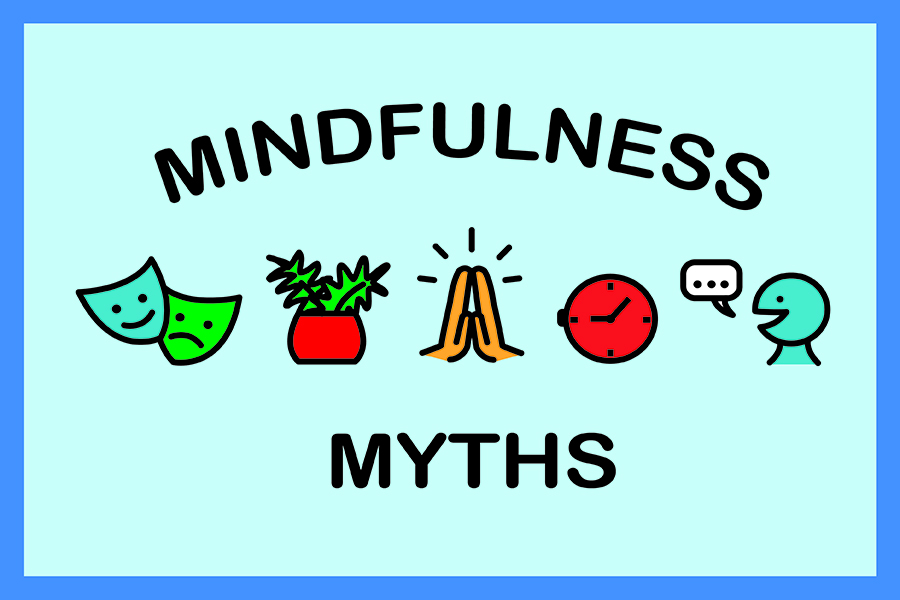
Mindfulness Myths Deconstructed
These days, mindfulness is a word we see used everywhere from college campuses and large corporations to the military and on social media, yet in spite of its widespread usage (or, perhaps, because of it) many people still carry misconceptions and false cultural associations that might impede them from fully accessing the benefits of mindfulness practices.
So, what are some myths that might be holding some people back?
1. Mindfulness is a religion.

It is important to acknowledge that many contemplative practices came to the West from Eastern traditions. Many of the practices we are engaging with today have roots that date back thousands of years and have been refined through dedicated practice. They were passed down from generation to generation, were woven into religious practices for many, while for others they served more as spiritual pathways situated outside of mainstream religion.
While many Eastern and Western religions have themes of mindfulness woven into the fabric of their teachings and practices, today mindfulness can be engaged with by anyone for a multitude of reasons. The practices awaken a human capacity that allows each person to access their innate ability to step back, observe with more intention, feel more fully, be more compassionate and make more conscious choices in our day-to-day lives. Most often these results support us to feel more connected to ourselves, others, and the world/nature at large.
2. Mindfulness is meditation (and involves a quiet mind and still body).
 Meditation is an integral part of mindfulness, but confusion often springs up around what meditation is exactly. Formal seated meditation practice (which, in many traditions, allows for conscious movement when we experience discomfort) can be beneficial, but isn’t the only way to practice mindfulness.
Meditation is an integral part of mindfulness, but confusion often springs up around what meditation is exactly. Formal seated meditation practice (which, in many traditions, allows for conscious movement when we experience discomfort) can be beneficial, but isn’t the only way to practice mindfulness.
Meditation is simply a technique that increases our ability to channel our attention: choosing to focus on something so we become absorbed and more immersed in it. Moreover, meditation or being attentive can happen anywhere: on a nature walk, riding a bike, washing the dishes, painting, cooking, sitting, breathing or fully listening to someone in a conversation.
It is normal for the mind to wander, so quietness isn’t required for mindfulness practice. The key is to be able to acknowledge or notice when the mind has moved elsewhere and then choose where to focus next. While we might notice more space in the mind, practice is more about being curious where our mind goes, what stories it makes up, and how we best navigate the vast inner ocean of thought and belief.
3. Mindfulness requires constant joy and positivity.
 While many people who take time to strengthen their “mindfulness muscle” report feeling a greater sense of overall wellbeing and positive outlook, a key aspect of mindfulness is welcoming whatever is present, be it bitter or sweet. In fact, many people experience more fulfillment because they carve out time to be with their challenges instead of glossing over them and pretending that everything is on track. By stepping back and holding space for whatever season or weather we find ourselves in, we create a landscape of compassion which makes it easier to step into skillful action when we are ready to move forward.
While many people who take time to strengthen their “mindfulness muscle” report feeling a greater sense of overall wellbeing and positive outlook, a key aspect of mindfulness is welcoming whatever is present, be it bitter or sweet. In fact, many people experience more fulfillment because they carve out time to be with their challenges instead of glossing over them and pretending that everything is on track. By stepping back and holding space for whatever season or weather we find ourselves in, we create a landscape of compassion which makes it easier to step into skillful action when we are ready to move forward.
4. Mindfulness requires too much time.
 The human brain is an amazing instrument which responds very quickly to positive behavioral changes. Even three minutes of mindfulness practice (e.g. deep breathing, keeping a journal of things you are grateful for, or sitting with nature) for three days a week will start to move the nervous system into more of a parasympathetic state, rewiring neural pathways in the brain.
The human brain is an amazing instrument which responds very quickly to positive behavioral changes. Even three minutes of mindfulness practice (e.g. deep breathing, keeping a journal of things you are grateful for, or sitting with nature) for three days a week will start to move the nervous system into more of a parasympathetic state, rewiring neural pathways in the brain.
The key is to schedule time to begin building a habit of practice. It might be as simple as walking without looking at your phone, driving without listening to the news or music on the way back from work, eating one meal a week without any other distraction, or taking time to sit in nature and breathe deeply for three minutes.
5. Mindfulness is just another fad.
 The reality is most people wouldn’t stick with something for the long term if they were not getting something out of it. Mindfulness has grown with the spread of yoga, meditation, and the recognition that the trajectory of modern day living is headed in a potentially destructive direction.
The reality is most people wouldn’t stick with something for the long term if they were not getting something out of it. Mindfulness has grown with the spread of yoga, meditation, and the recognition that the trajectory of modern day living is headed in a potentially destructive direction.
While mindfulness might not be for everyone, the only way to truly find out is to run your own experiment and make a decision based on your own personal data. Mindfulness practices have the ability to add richness, connection, perspective, compassion, and greater fulfillment to daily life and are here to stay. By enacting small practices, we can fulfill these basic human needs, which don’t require any prerequisites or specific belief system—only the desire to explore.
Now that you’ve dispelled some mindfulness myths, get yourself moving more mindfully with a UW Recreation Summer Mindfulness Pass for Yoga or Meditation.
 Danny Arguetty, M.A., is the mindfulness program manager at the University of Washington, a yoga teacher (and teacher trainer), nutrition/life coach, and a lover of the environment. He is the author of Nourishing the Teacher and The 6 Qualities of Consciousness. Passionate about helping people flourish through mindfulness, wellness, and personal self-development, he has over a decade’s worth of experience in group facilitation, one-on-one coaching, and experiential teaching.
Danny Arguetty, M.A., is the mindfulness program manager at the University of Washington, a yoga teacher (and teacher trainer), nutrition/life coach, and a lover of the environment. He is the author of Nourishing the Teacher and The 6 Qualities of Consciousness. Passionate about helping people flourish through mindfulness, wellness, and personal self-development, he has over a decade’s worth of experience in group facilitation, one-on-one coaching, and experiential teaching.
Danny has guided workshops throughout the United States, led basic and advanced yoga trainings in the U.S. and India, and spoken at Facebook, Olson Kundig, and Gravity Payments (all in Seattle). He served as adjunct faculty at Williams College, leads a quarterly course on Intro to Mindfulness at UW, and is a faculty member at Kripalu Center for Yoga & Health.